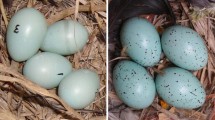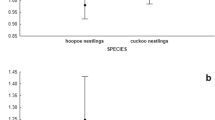Abstract
Adult female bethylid parasitoids (Hymenoptera: Bethylidae) commonly guard their offspring until they develop into later immature stages to protect them from competing parasitoids and predators. Another possible mortality factor is from caterpillar larvae that cannibalize parasitized conspecific larvae. This study determined the effect of brood guarding on the occurrence of host cannibalism by using a brood guarding bethylid parasitoid Goniozus legneri and a non-guarding braconid parasitoid Habrobracon gelechiae (Hymenoptera: Braconidae), both are gregarious ectoprasitoids that attack the obliquebanded leafroller Choristoneura rosaceana (Lepidoptera: Tortricidae). When a C. rosaceana larva parasitized by G. legneri was presented to a live conspecific larva, the frequency of cannibalism on the parasitized conspecific was lower in the presence than in the absence of a guarding female G. legneri. In contrast, when a C. rosaceana larva parasitized by H. gelechiae was presented to a live conspecific larva, the presence or absence of H. gelechiae did not affect cannibalism frequency. Cannibals did not gain a fitness advantage in terms of larval survival, developmental time, or body mass of developed pupae; therefore, cannibalism by the host larva may be a group defense against increased parasitism in subsequent population generations. We suggest that brood guarding by parasitoids can act as a broad defense strategy to protect offspring from the cannibalism of parasitized conspecifics by the host larvae.
Similar content being viewed by others
References
Ashall C, Ellis P (1962) Studies on numbers and mortality in field populations of the desert locust (Schistocerca gregaria Forskål). Anti-Locust Bull 38:59
Bentley T, Hull TT, Hardy ICW, Goubault M (2009) The elusive paradox: owner-intruder roles, strategies, and outcomes in parasitoid contests. Behav Ecol 20:296–304
Boots M (1998) Cannibalism and the stage-dependent transmission of a viral pathogen of the Indian meal moth, Plodia interpunctella. Ecol Entomol 23:118–122
Chapman JW, Williams T, Escribano A, Caballero P, Cave RD, Goulson D (1999a) Fitness consequences of cannibalism in the fall armyworm, Spodoptera frugiperda. Behav Ecol 3:298–303
Chapman JW, Williams T, Escribano A, Caballero P, Cave RD, Goulson D (1999b) Age-related cannibalism and horizontal transmission of a nuclear polyhedrosis virus in larval Spodoptera frugiperda. Ecol Entomol 24:268–275
Church SC, Sherratt TN (1996) The selective advantages of cannibalism in a Neotropical mosquito. Behav Ecol Sociobiol 39:117–123
Clausen CP (1978) Introduced parasites and predators of arthropod pests and weeds: a world review. USDA Agricultural Handbook No. 480, Washington D.C.
Clutton-Brock TH (1991) The evolution of parental care. Princeton University Press, Princeton
Daane KM, Wang XG, Duerr S, Kuhn E, Yokota GY, Son Y (2013) Biology of Habrobracon gelechiae (Hymenoptera: Braconidae), as a parasitoid of the obliquebanded leafroller (Lepidoptera: Tortricidae). Environ Entomol 42:107–115
Dong Q, Polis GA (1992) The dynamics of cannibalistic populations: a foraging perspective. In: Elgar MA, Crespi BJ (eds) Cannibalism— ecology and evolution among diverse taxa. Oxford Science, Oxford, pp 13–37
Field SA, Calbert G (1998) Patch defense in the parasitoid wasp Trissolcus basalis: when to begin fighting? Behavior 135:629–642
Fox LR (1975) Cannibalism in natural populations. Annu Rev Ecol System 6:87–106
Griffiths NT, Godfray HCJ (1988) Local mate competition, sex ratio and clutch size in bethylid wasps. Behav Ecol Sociobiol 22:211–217
Hamilton WD (1964) The genetical evolution of social behavior. J Theoret Biol 7:1–52
Hardy ICW, Blackburn TM (1991) Brood guarding in a bethylid wasp. Ecol Entomol 16:55–62
Hardy ICW, Goubault M, Batchelor TP (2013) Hymenopteran contests and agonistic behavior. In: Hardy ICW, Briffa M (eds) Animal contests. Cambridge University Press, Cambridge, pp 147–177
Hart BL (1990) Behavioral adaptations to pathogens and parasites: 5 strategies. Neurosci Biobehav Rev 14:273–294
Holmes ND, Nelson WA, Peterson LK, Farstad CW (1963) Causes of variations in effectiveness of Bracon cephi (Gahan) (Hymenoptera: Braconidae) as a parasite of the wheat stem sawfly. Can Entomol 95:113–126
Hu Z, Zhao X, Li Y, Liu X, Zhang Q (2012) Maternal care in the parasitoid Sclerodermus harmandi (Hymenoptera: Bethylidae). PLoS ONE 7:e51246
Jervis MA (2007) Insect as natural enemies, a practical perspective. Springer, The Netherlands
Joyner K, Gould F (1985) Developmental consequences of cannibalism in Heliothis zea (Lepidoptera, Noctuidae). Ann Entomol Soc Am 78:24–28
Kakimoto T, Fujisaki K, Miyatake T (2003) Egg laying preference, larval dispersion and cannibalism in Helicoverpa armigera (Lepidoptera: Noctuidae). Ann Entomol Soc Am 96:793–798
Krugner R, Daane KM, Lawson AB, Yokota GY (2005) Biology of Macrocentrus iridescens (Hymenoptera: Braconidae): a parasitoid of the obliquebanded leafroller (Lepidoptera: Tortricidae). Environ Entomol 34:336–343
Legner EF, Silveira-Guido A (1983) Establishment of Goniozus emigrates and Goniozus legneri (Hym.: Bethylidae) on navel orangeworm, Amyelois transitella (Lep.: Phycitidae) in California and biological control potential. Biocontrol 28:97–106
Leigh EG Jr (2010) The group selection controversy. J Evol Biol 23:6–19
MacNeil G, Dick JJT, Hatcher MJ, Fielding NJ, Hume KD, Dunn AM (2003) Parasite transmission and cannibalism in an amphipod (Crustancea). Inter J Parasitol 33:795–798
Mayhew PJ, Hardy CW (1998) Nonsiblicidal behavior and the evolution of clutch size in Bethylid wasps. Am Nat 151:409–424
Obregón R, de Haro S, Jordano D, Haeger JF (2012) Lampides boeticus (Lepioptera: Lycaenidae) preys on cocoons of its own specific parasitoid Cotesia specularis (Hymenoptera: Braconidae). J Insect Behav 25:514–517
Pérez-Lachaud G, Batchelor TP, Hardy CW (2004) Wasp eat wasp: facultative hyperarasitism and intra-guild predation by bethylid wasps. Biol Control 30:149–155
Pfennig DW, Reeve HK, Sherman PW (1993) Kin recognition and cannibalism in spadefoot toad tadpoles. Anim Behav 46:87–94
Pierce NE (1995) Predatory and parasitic Lepidoptera: carnivores living on plants. J Lepidopterist’s Soc 49:412–453
Pizzatto L, Shine R (2011) You are what you eat: parasite transfer in cannibalistic cane toads. Herpetologica 67:118–123
Polis GA (1981) The evolution and dynamics of intraspecific predation. Annu Rev Ecol System 6:87–106
Quicke DJ (1997) Parasitic wasps. Chapman and Hall, London
Reed DJ, Begon M, Thompson DJ (1996) Differential cannibalism and population dynamics in a host-parasitoid system. Oecologia 105:189–193
Richardson ML, Mitchell RF, Reagel PE, Hanks LM (2010) Causes and consequences of cannibalism in noncarnivorous insects. Annu Rev Entomol 55:39–53
Rudolf VHW, Antonovics J (2007) Disease transmission by cannibalism: rare event or common occurrence? Proc Royal Soc B: Biol Sci 274:1205–1210
Tallamy DW (2001) Evolution of exclusive paternal care in arthropods. Annu Rev Entomol 46:139–165
Tebbets JS, Curits CE, Fries RD (1978) Mortality of immature stages of the navel orangeworm stored at 3.5 °C. J Econ Entomol 71:875–876
Wang XG, Daane KM (2014) Cannibalism of parasitoid-attacked conspecifics in a non-carnivorous caterpillar. Entomol Exp Appl 151:112–121
Wang XG, Hogg BN, Levy K, Daane KM (2013a) Predicting the outcomes of a tri-trophic interaction between an indigenous parasitoid and an exotic herbivorous pest and its host plants. Ann Appl Biol 163:288–297
Wang XG, Levy K, Daane KM (2013b) Evaluation of an indigenous parasitoid Habrobracon gelechiae (Hymenoptera: Braconidae) for biological control of light brown apple moth in California. Biocontrol Sci Techn 23:433–447
Weaver DK, Nansen C, Runyon JB, Sing SE, Morrill WL (2005) Spatial distributions of Cephus cinctus Norton (Hymenoptera: Cephidae) and its braconid parasitoids in Montana wheat fields. Biol Control 34:1–11
Williams T, Hernández O (2006) Costs of cannibalism in the presence of an iridovirusm pathogen of Spodoptera frugiperda. Ecol Entomol 31:106–113
Wilson DS (1975) A theory of group selection. PNAS 72:143–146
Acknowledgments
We thank the California Pistachio Commission, the California Department of Food and Agriculture, and University of California IPM Grants Program for financial support.
Conflict of Interest
We have no known conflict of interest with the work presented herein.
Author information
Authors and Affiliations
Corresponding author
Rights and permissions
About this article
Cite this article
Wang, XG., Tomajan, S.M. & Daane, K.M. Brood Guarding by an Adult Parasitoid Reduces Cannibalism of Parasitoid-Attacked Conspecifics by a Caterpillar Host. J Insect Behav 27, 826–837 (2014). https://doi.org/10.1007/s10905-014-9474-0
Revised:
Accepted:
Published:
Issue Date:
DOI: https://doi.org/10.1007/s10905-014-9474-0




